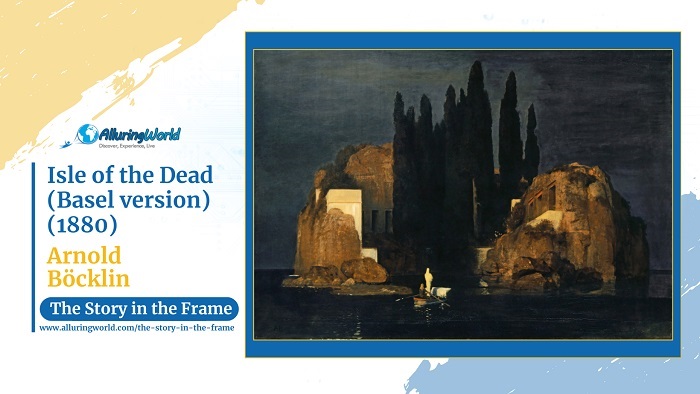The Isle of the Dead (Basel version) is the earliest painting of five versions that were created by the Swiss artist Arnold Böcklin, and this version was painted in 1880. This haunting and atmospheric masterpiece is considered to be one of the most enigmatic paintings of the 19th century since it is evoking a deep sense of mystery, solitude, and the unknown, and the image of a small boat carrying a lone figure toward a dark, rocky island surrounded by still waters has fascinated audiences for generations, inspiring countless interpretations and influencing literature, music, and film.
About the Painter:
Arnold Böcklin (1827–1901) was a Swiss Symbolist painter known for his ability to blend reality with mythological and dreamlike elements. His works often explored themes of death, solitude, and the supernatural, creating an otherworldly quality that set him apart from his contemporaries. Böcklin’s style combined Romanticism with an eerie, psychological depth, making his paintings deeply evocative. His fascination with classical mythology, nature, and the afterlife is evident in many of his works, particularly with this masterpiece, which became his most famous painting and a defining image of Symbolist art.
Inspiration and Reasons Behind the Painting:
The Isle of the Dead was inspired by Böcklin’s time in Italy, particularly his visits to the small island cemetery of San Michele in Venice. The concept of a lonely island as a final resting place for the departed fascinated him so much that he sought to capture the quiet solemnity of such a scene. Additionally, the painting may have been influenced by his personal experiences with loss, as he created it for Marie Berna who was a widow who had recently lost her husband. The overall composition invites viewers to contemplate mortality, the afterlife, and the journey of the soul into the unknown.
What is Depicted in the Painting:
The painting shows a solitary rowboat gliding across dark, motionless waters towards a rocky island covered with towering cypress trees. A white-clad figure stands near the coffin in the boat which could be symbolizing either a grieving soul accompanying the dead or a representation of Charon, who was the mythological ferryman of the underworld. The island itself is quite a towering one, with its sheer cliffs and hidden burial chambers clearly lit and visible from afar, and as the islet looms over the water like an ominous gateway to eternity, the unfortunate absence of wind or waves enhances the eerie stillness, reinforcing the painting’s meditative and solemn atmosphere.
Colors and Techniques:
Böcklin’s color palette in the Basel version is dominated by quite dark earth tones, deep blues, and grays, creating a somber and melancholic mood. The pale white of the central figure and the coffin contrasts starkly against the darkness, drawing the viewer’s eye toward the theme of death and passage. Böcklin’s detailed brushwork in the rendering of the trees, rocks, and water enhances the realism of the scene while maintaining an ethereal, dreamlike quality. The subtle gradations of light and shadow add depth, making the island feel both solid and ghostly, as if it exists in a realm between life and death.
Conclusion:
In conclusion, the Isle of the Dead (Basel version) remains one of the most hauntingly beautiful and psychologically compelling paintings in art history. Böcklin’s masterful use of symbolism, atmosphere, and color creates an unforgettable vision of mortality and the unknown, and as the painting has influenced artists, writers, and even composers, most notably inspiring Sergei Rachmaninoff’s symphonic poem of the same name, even today, it continues to captivate viewers with its quiet intensity, inviting them to reflect on the passage of life and the mysteries beyond.

